Clark Family in Rouse Island in Gabarus Nova Scotia
SEAL ISLAND LIGHTHOUSE
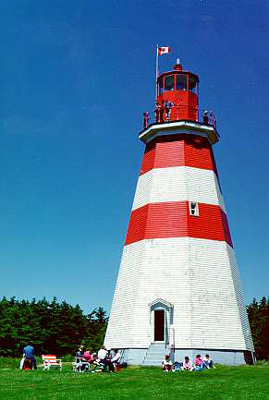 Seal Isle Lighthouse 1990
Seal Isle Lighthouse 1990
ACKNOWLEDGEMENT:
Contributor: Chris Mills, Assistant Lightkeeper, Seal Isle Lighthouse, 1989/xc
Sources: Research and personal knowledge.
Photograph - © Chris Mills
Description
The 67 foot timber lighthouse on the island is the original, built 1830-31, the lantern is an aluminium replacement installed in 1978. It contains a modern beacon. The Seal Island Lighthouse Museum In Barrington Nova Scotia is a 35 foot high replica of the top half of the Seal Island Lighthouse. It is crowned by the cast-iron lantern which was removed from the lite in 1978 and houses the Fresnel Lens which was also removed at that fourth dimension.
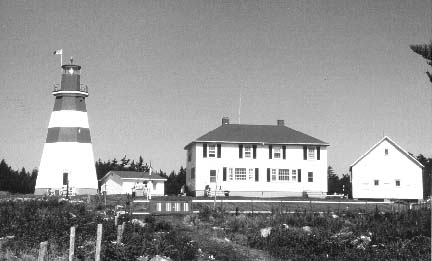 This is the station before it was de-staffed, showing the large double keepers` house.
This is the station before it was de-staffed, showing the large double keepers` house.
Seal Island Lighthouse 1990
Photograph - © Chirs Mills
Early History
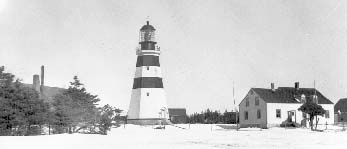 Seal Island Lighthouse c. 1930
Seal Island Lighthouse c. 1930
Note Second Order lantern and lens, now at the Seal Isle Light Museum, Barrington. The building behind the copse on the left houses the steam fog whistle.
Photograph - © Courtesy Mary Nickerson
Before anyone lived on Seal Isle, shipwrecked mariners lucky enough to take reached its shores alive often died of starvation and exposure during the harsh winter months. By the early years of the nineteenth century a grim spring tradition had evolved, as preachers and residents from Yarmouth and Barrington came to the island to find and bury the expressionless. There was much concern about the loss of life (on one occasion 21 people were buried in shallow graves in a single mean solar day) and in 1823, ii families, the Hichens and the Crowells settled on the island in the hopes of assisting the unfortunate souls cast ashore during the wintertime storms. Richard Hichens himself had been shipwrecked on Cape Sable in 1817 and later married Mary Crowell, who had heard firsthand many stories of the deaths on Seal Isle from her male parent, a Barrington preacher.
 After settling on the island, Richard Hichens and Edmund Crowell soon began to petition the provincial government for money to construct a wharf and "for funds for 2 skilful boats and then that they might meliorate serve shipwrecked ocean men." In 1827 a wharf was completed, making it easier for lifeboats to attend to rescues in the surface area. Later the same year, at the urging of Hichens and Crowell, Nova Scotia governor Sir James Kempt surveyed a location for the erection of a lighthouse 500 metres from the shore nigh the southern tip of the island. Construction began in 1830; the big forest construction was built of massive squared timbers, 47 feet long, framed and set in a rock and mortar foundation. The lantern floor was reinforced with heavy wood knees, and stout cross members braced the rest of the tower. On the dark of Nov 28, 1831 the stock-still light was lit for the first time. A daughter was built-in to Richard and Mary that same evening, and then began a family lightkeeping tradition that would terminal more than a century on Seal Island.
After settling on the island, Richard Hichens and Edmund Crowell soon began to petition the provincial government for money to construct a wharf and "for funds for 2 skilful boats and then that they might meliorate serve shipwrecked ocean men." In 1827 a wharf was completed, making it easier for lifeboats to attend to rescues in the surface area. Later the same year, at the urging of Hichens and Crowell, Nova Scotia governor Sir James Kempt surveyed a location for the erection of a lighthouse 500 metres from the shore nigh the southern tip of the island. Construction began in 1830; the big forest construction was built of massive squared timbers, 47 feet long, framed and set in a rock and mortar foundation. The lantern floor was reinforced with heavy wood knees, and stout cross members braced the rest of the tower. On the dark of Nov 28, 1831 the stock-still light was lit for the first time. A daughter was built-in to Richard and Mary that same evening, and then began a family lightkeeping tradition that would terminal more than a century on Seal Island.
The Second Order Fresnel Lens from Seal Island Lighthouse
This lens is now installed at the Seal Island Light Museum, Barrington.
Photo - Kathy Brown
Afterward History
 Seal Island Lighthouse 1997
Seal Island Lighthouse 1997
© Kathy Brown
Past the early 1970s, radar and LORAN systems were becoming common in the smaller boats, and the Canadian Coast Guard began to implement their lightstation automation program. At Seal Island the low-cal and horn were semi-automated, and the duties of the keepers reduced to general maintenance. Information technology was a desperate change from the early days when manually operated equipment and scout duties kept the keepers busy 24 hours a mean solar day.
The early keepers had been a dedicated lot, as much through necessity every bit choice. It was a full time chore to maintain the low-cal, fog whistle and buildings, as well as raise animals and crops for survival. In 1901, Barrington Notes in a local paper remarked that "John Crowell [Winifred Hamilton'south father], lightkeeper from Seal Island, is taking a much needed holiday, his place existence filled by Squire Covert of North East Point." Information technology was to be a long time before Crowell took another vacation. His daughter claimed that between 1902 and 1917 John Crowell did not accept i day of holidays, nor did he miss one watch at the lightstation. Crowell served as keeper of the lite for a full of 36 years. With his retirement in 1927, the light passed out of Crowell easily, although Winifred's husband was appointed keeper and served until 1939 when sick health forced him to get out the island.
By 1986 the keepers' families had been moved off the isle and the station changed to rotational status, with two teams of two keepers working alternate 28 day shifts. In 1989 work crews from the Declension Baby-sit Base in Saint John began constructing a new engine room by the tower and installing remote monitoring equipment; by the summer of 1990 the piece of work was complete. At 7:30 in the morn of the 17th of October, lightkeeper James Nickerson transmitted the station'south final weather report to Yarmouth Coast Guard Radio. That afternoon, the light became officially unwatched, bringing an finish to 159 years of staffed history. Principal keeper Brian Stoddard had departed the island one solar day earlier, leaving the husband of Mary Hichens great- grandniece to finish duties at the lighthouse for the last time.
The Light Today
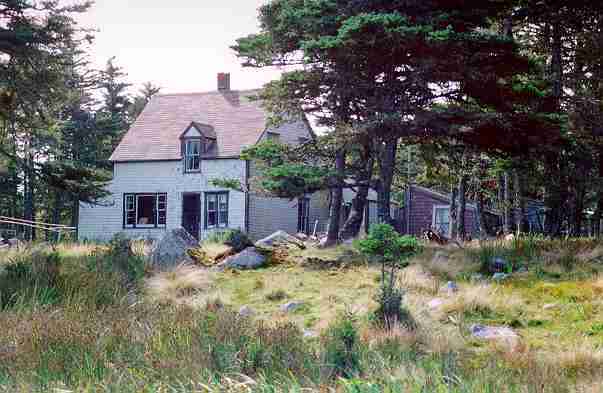 Today Seal Isle is in a state of turn down. Simply a handful of houses and sheds, a church and the automatic lighthouse remain on an island that one time boasted a permanent population, lobster cannery, mail part and fifty-fifty a phone line to the mainland. This decline is nothing new for remote lighthouse and angling islands off the Atlantic coast- many settlements were abandoned in the early on twentieth century when gas boats and mainland civilities drew people away from their island homes. 50 years agone Thomas Raddall wrote about Seal Isle in a Saturday Evening Post article: "For six months in the year the weathered greyness dwellings beside the 2 coves are ghost villages without a living soul, and even in the lobster season many of them are tenantless and tottering to ruin." Today, the village on the due west side of the island has experienced growth in the course of new sheds and fishermen's houses. Clark's Harbour men still lobster from the island, bunking in the old cookhouse above the government wharf.
Today Seal Isle is in a state of turn down. Simply a handful of houses and sheds, a church and the automatic lighthouse remain on an island that one time boasted a permanent population, lobster cannery, mail part and fifty-fifty a phone line to the mainland. This decline is nothing new for remote lighthouse and angling islands off the Atlantic coast- many settlements were abandoned in the early on twentieth century when gas boats and mainland civilities drew people away from their island homes. 50 years agone Thomas Raddall wrote about Seal Isle in a Saturday Evening Post article: "For six months in the year the weathered greyness dwellings beside the 2 coves are ghost villages without a living soul, and even in the lobster season many of them are tenantless and tottering to ruin." Today, the village on the due west side of the island has experienced growth in the course of new sheds and fishermen's houses. Clark's Harbour men still lobster from the island, bunking in the old cookhouse above the government wharf.
The due east side village is a ghost town. A few years ago the breakwall protecting the government landing was washed away and concluding winter storms tore up the slip way. The freighter Fermont, run aground one year after the last keeper had left the lighthouse, sits difficult on the sand of the e embankment. Last winter's storms broke its back and tore the rusted hull into ii mammoth, ragged pieces. Beneath Winifred Hamilton's homestead, the last lifeboat sits abandoned, a reminder of the days when the island and its keepers were so crucial to the safety of aircraft.
© Courtesy Mary Nickerson
The Hamilton Business firm Seal Island Lighthouse
For seven or eight months of the year, Mary and Jim Nickerson alive in a house stone's throw from Mary's mother's homestead. The 1906 church has been refurbished and stands in stark contrast to the bedraggled landing and abandoned lobster traps. Nearby, the road to the lighthouse still winds through the scraggly spruce but at the stop of the lane the station is deserted. The lighthouse (the oldest operating wooden low-cal in Canada) continues to operate automatically with a small diesel generator powering the light and the fog horn. There is a large aluminum security door on the tower, complete with heavy duty padlock, and a sign warning "No trespassing. Building fitted with intrusion alert". Just there is still a palpable sense of history in the old tower. An incandescent lightbulb on each landing casts a dim low-cal on the huge whitewashed timbers. Names of lightkeepers and visitors, some dating dorsum a century, are scrawled hither and in that location on the beams. Those beams and the braces, the very skeleton of the lighthouse, are the last intact pieces of the by here, and they evoke some of the history of the place.
 Wreck of the Fermont on Seal Isle, 1997
Wreck of the Fermont on Seal Isle, 1997
This send was driven aground on the beach on the inner side of the island.
© Peter MacCulloch
Of the older station buildings, only the barn built past Ellsworth Hamilton (Winifred'south Husband) and the house used by the radio operator, remain. The duplex, built in 1953 to supercede the original Hichens/Crowell house, has been torn down and the domestic engine room has been stripped for it'due south lumber. Its roof sits partly on the wood flooring of the building and grey paint peels off the former engine beds. The huge, crimson sliding door has been removed from the barn and sheep wander in and out of the gaping entrance. Below the foundation of the old house, the 1870 fog whistle boiler still stands, a rusty, bony finger of atomic number 26 pointing skyward from the firebox.
The Seal Isle lightstation was a constant in the history of the island. It was a government presence, a center of lifesaving and communications and assist. Only remnants of the station'south past live on, in the stories of Mary Nickerson, and in the broad sweep of the light that continues to guide vessels past the "wicked elbow" of the bay.
As part of the Canadian Coast Guard'southward review of aids to navigation, some changes take taken place in the past few years at the Seal Island lightstation. The radio buoy, established in 1924, has been discontinued. The lighthouse has been solarized and the diesel generating system removed. The light has been slightly downgraded from 25 to approximately 21 miles range. It is proposed to retain the existing iii mile fog horn because of the ledges off the southern end of the island. The station is presently monitored daily (non continuously as in the past) via VHF link by the lightkeepers at the Machias Seal Island Lightstation in New Brunswick
Location
 Seal Island lies off the south westward tip of Nova Scotia at "the elbow of the Bay of Fundy", where the broad oral fissure of the bay meets the waters of the open Atlantic. For more than three centuries storms, fog and powerful tides have conspired to wreck scores of ships on the isle and it'south surrounding ledges. At least 160 vessels take come to grief in the expanse, making Seal Island historically one of Atlantic Canada'southward almost dangerous areas for shipping, along with Sable and St. Paul's Islands. Although no major wrecks have occurred since the 1940s, the waters around Seal Island continue to command the respect and caution of fishermen and mariners.
Seal Island lies off the south westward tip of Nova Scotia at "the elbow of the Bay of Fundy", where the broad oral fissure of the bay meets the waters of the open Atlantic. For more than three centuries storms, fog and powerful tides have conspired to wreck scores of ships on the isle and it'south surrounding ledges. At least 160 vessels take come to grief in the expanse, making Seal Island historically one of Atlantic Canada'southward almost dangerous areas for shipping, along with Sable and St. Paul's Islands. Although no major wrecks have occurred since the 1940s, the waters around Seal Island continue to command the respect and caution of fishermen and mariners.
Slightly less than three miles long and between a half and one mile wide, the island is eighteen miles west of Cape Sable Island. A modern Cape Island fishing boat can make the trip from Clark'due south Harbour in 2 hours, weather permitting. From a distance, the island is unremarkable, a pencil thin smudge on the horizon. Most of the island consists of glacial till, thickly covered with stunted, air current blown spruce trees. At the due north end there are steep gravelly bluffs above the shingle beach. A long sandy beach stretches between granite and gravel bluffs on the eastward side, and between the north and due south ends a long bulwark beach and a series of grassy dunes define a stagnant pond. Within the forest in that location are quiet glades where moss covered ground and the winding paths trodden by generations of sheep create an temper of mystery and magic. Hot summer days, placid seas and expansive golden sand beaches confute the vicious storms which led to the destruction of many fine sailing ships in the days before the lighthouse was established.
Visit Seal Island
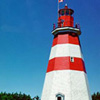 In the by, NSLPS hosted a guided trip every other summer to Seal Island. Unfortunately, it has been over a decade since NSLPS was able to mount a trip to the isle. For information about any upcoming tours, go to the Events and Tours folio.
In the by, NSLPS hosted a guided trip every other summer to Seal Island. Unfortunately, it has been over a decade since NSLPS was able to mount a trip to the isle. For information about any upcoming tours, go to the Events and Tours folio.
In the past, Charles Kenney at Seal Isle Tours has taken people out to Seal Isle. The island is 2 hours offshore and a trip involves staying at least overnight. His boat is at Clark's Harbour on Cape Sable Island. At this fourth dimension, we are unaware of the status of Seal Isle Tours.
SEAL Isle - Light Details
- Location: Southern point of isle
- Standing: This lite is still standing.
- Operating: This light is operational
- Automated: All operating lights in Nova Scotia are automated.
- Appointment Automatic: Automated by 1990
- Began: 1827
- Appointment Lit: November 28, 1831
- Year Lit: 1831
- Structure Type: Octagonal wood tower, white, red bands
- Light Characteristic: Flashing White (1992)
- Tower Tiptop: 068ft feet high.
- Light Height: 102ft anxiety above water level.
- Solarized: This light has been solarized.
History Items for This Lighthouse
- 1823 - Hichens and Crowell families began lifesaving station
- 1922 - 1941 - 2nd order dioptric lens - 1930 - compressed air diaphone
- 1959 - converted to electricity - 1870 - fog signal established
- 1978 - original lantern dismantled, reassembled in replica in Barrington
Lightkeepers
Lightkeepers for Seal Island Lighthouse
- Hichens, Capt. Richard 1831-1855
- Crowell, Edmund 1831-1855
- Crowell, Corning 1855-1870
- Crowell Jr., Corning 1870-1891
- Crowell, John 1891-1927
- Hamilton, Ellsworth 1927-1941
- Spinney, Lewis 1941-1946
- Gallant, Edward 1946-1950
- Jeffrey, Elijah 1950-1951
- Flemming, Bradford 1951-1973
- Swim, Maurice 1973-1977
- Nickerson, Jim 1977-1978
- Tiner, Ray 1978-1985
- Penney, Clayton 1985-1990
Source: https://www.nslps.com/about-ns-lighthouses/lighthouse-lists?c=seal-island-lighthouse
0 Response to "Clark Family in Rouse Island in Gabarus Nova Scotia"
Post a Comment